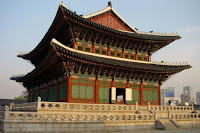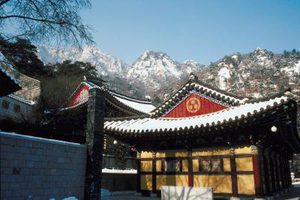 |
The Flow of the Korea
History From Pre-history
to Joseon Dynasty
|
As from the diagram we know that the history of Korea
started from the pre-history which is about 700,000 years ago. We can separate
pre-history into two period that are Jeulmun Pottery Period and Mumun Pottery
Period. In the Jeulmun Pottery Period, the earliest known Korean pottery was at
about 8000 B.C.E. or before. At Mumun Pottery Period (150-300 B.C.E), the
earliest agricultural societies and the earliest form of social political
society complexity.
According to
the legend, the first Korean kingdom is at Gojoseon Period which is called
Dangun (2333 B.C.E), that is located in the southern part of Manchuria and the
northern part of Korea peninsula. Furthermore, the bronze culture and iron
culture will also found in Gojoseon period.
At 57 B.C.E to
668 AD, the three kingdom Baekje, Silla and Goguryeo presented in the three
kingdom periods. After the fall of the Gojoseon numerous state sprang up, this
include Bukbuyeo, Dongbuyeo, Okjeo, Dongye, Nangnang Joseon and Samhan. This
state from in the Proto-Three Kingdoms which is the period before the rise of
the Three Kingdoms Period.
After the Three Kingdom Period, started the
North-South States Period which contain of two kingdoms which is Silla
(668-935) and Balhae (698-926). After this period, existed the Later Three
Kingdom Period (892-936) which consist of Silla, Hubaekje (later called
Baekje), and Taebong (Hugoguryeo, later called Goguyeo).
 |
| Goryeo Pargoda |
Goryeo founded
in 913 until year 139. At this period the courts codified laws and civil
service system is introduced by the government.
Buddhism spread through the peninsula of Korea. The celadon industry
which celadon is a type of ceramic was flourished, the world’s first metal
printing technology and the publication of Tripitaka Koreana were achieve in
this period. In 1231, the Mongola started its campaigns against Korea and after
25 years of resistant the royal family surrended. Goryeo dynasty had under the
influenced of Mongola for 80 years. In 1340s, the Mongola decline and King Gongmin
found the freedom to reform Goryeo government but it faced various problems.
Moreover, “Japanese” pirates organized raid deep into the country and is
repelling by the engagement formed with General Lee Songgye.
 |
| White Porcelain Jar with Plum, Bamboo, Bird Design (Joseon; 15th Century). This vase made in the early Joseon Period. |
In year 1392, Joseon dynastry was established. In this period
Neo-Confucianism was the country’ s official religion and advanced in science
and culture which created the Hangul written alphabet. The economy was stable
during peaceful period but suffered after Janpanese invasion. The social
hierarchy system in this period is shown in the diagram below.
 |
| Social Hierarchy system in Joseon Dynasty |
Korea had suffered from a pair of invasion from 1592
to 1598. Subsequently Korea was invaded twice in 1627 and 1636 by Manchus which
conquer China and establish the Qing dynasty after Korea recognized controlled.
During 19th century, Korea closed their borders to all nation except
China to control the foreign invasion. The Joseon court noted with concern the
foreign invasions and treaties involving Qing China, as well as the Opium Wars
and followed by a slow exchange of policy with the west. “General Sherman”
incident in 1866 causes Korea and United States into a confrontational
relationship. In 1871, United States conducted a limited punitive expedition
which is Sinmiyangyo. Japan forced Korea to open its port in 1876 and
successfully challenges Qing in Sino-Japanese War (1894-1895). In 1895, Empress
Myeongseong was murdered which was involved Japanese who had Russian help and
Russian was forced to leave from Korea.
 |
| The Korea History Flow from Korean Empire to the Division of Korea |
 |
| Portrait of King Gojong |
In 1897, Joseon was renamed to Korean Empire and King
Gojong became Emperor Gojong. In this period the government implied domestic
reform, strengthening military forces, developing commerce and industry and surveying
land ownership. Organizations like Independent Club to assert the rights of the
Joseon people. Russian influence was strong in the Empire until it was defeated
by Japan in Russo-Japanese War (1904-1905). Korea was becoming a protectorate
of Japan in 17 November 1905 but the 1905 Protectorate Treaty was promulgated
without the seal or commission by the Emperor Gojong. Following that many
intellectuals and scholars set up various organization and association for the
movement of independent. In 1909, independent activist An Jung-Geun
assassinated Ito Hirobumwhich is a former Resident-General of Korea. This
incident lead to the banning of all political organization and started the plan
of enlarging its colonization.
 |
| Gyeongbokgong Palace |
In 1910, Japan effectively annexed Korea by the Japan-Korea Annexation Treaty. This treaty is not accepted in Korea because it was not signed by the Emperor of Korea as required while Japan claim that the treaty is legal. Korea was controlled by Japan under the Governor-General of Korea until Japan was unconditional surrender to the Allied Forces on 15 August 1945 with de jure sovereignty passing from Joseon Dynasty to the Provisional Government of the Republic of Korea. Korea constructed European-styled transport and communication network across the nation that is facilitated by Japan to extract the resources and labor. The Japanese removed Joseon hierarchy, destroyed Gyeongbokgung palace and established a punitive series of measures which include the murdering of those who refused to pay taxes in the provinces.
 |
| 1st March Movement |
Emperor Gojong died in January 1919 with a rumor of poisoning lead to an independence rallies against Japanese invaders took place nationwide on March 1, this movement is suppressed by the Japan by killing 7000 peaceful demonstrator. Japan also burnt alive many Korean Christians. Korean independent fighters establish the Provisional Government of the Republic of Korea in Shanghai, China.This Provisional Government constituted the de jure government of the Korean people in year 1919-1948. After the Sino-Japanese War in 1937 and World War II, Japan attempted to eliminate Korea as a nation by eliminating Korean culture. Japan prohibited the use of Korean language and the Korean is forced to change their name into Japanese name. Some Korean left the peninsula of Korea to Manchuria and Primorsky Krai. Korean in Manchuria formed resistance group named Dongnipgun (Independence Army). During World War II, Japan forced Korean to support their war effort and conscripted girls and women as “comfort women” or sex slave.
 |
| Officials of the Provisional Government of the Republic of Korea pose for a photo in Shanghai, China |
At the Cairo Conference on 22 November 1943, Russia,
Britain and the United State of Kingdom (USA) agree that Korean shall become
free and independent. In February 1945, at Yalta the allies agreed to establish
a four-power trusteeship over Korea. In 9 August 1945, Soviet entered northern
Korea from Siberia and take over the area north of the 38th parallel
while in 8 September 1945 US administering the southern Korea.This had leaded to the division of Korea.
 |
| The 38th Parellel divided North and South Korea till the Korean War |
A conference convened in Moscow to discuss the future of Korea on
December 1945. In September 1947, United Nations General Assembly
mandated called for democratic national election but Soviet Union ignored it
and USA went ahead with the elections in the South. This result in a communist
dictatorship in North Korea and in the South is the democratic Republic of
Korea. In 12 December 1948, the United Nations recognized Republic of Korea as
the sole of legal government of Korea by its resolution 195 in the Third
General Assembly. Korean War broke out on June 1950 when North Korea invaded
massively at the South over the 38th parallel which lead to the ending
of hope of peaceful reunification at that time. After the war, the 1945 Geneva
conference failed to adopt a solution to unified Korea.
 |
| Korean War Veterans Memorial |
These are the video about Korean History and Korea War
[Korean Culture Series] A brief history of Korea
The Battles of The Korean War-Best History Documentary
To know more about Korean History and Korean War can refer to these links below:-
- http://koreanhistory.info/
- http://www.newworldencyclopedia.org/entry/History_of_Korea
- http://www.history.com/topics/korean-war
By : Rui Rui Tan Sze Yin








































